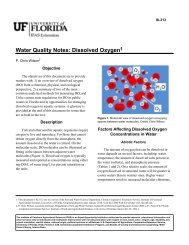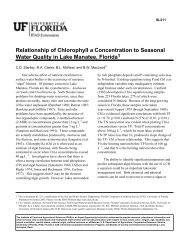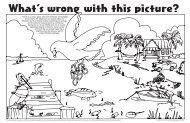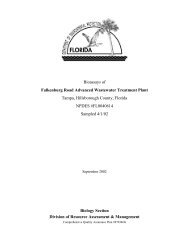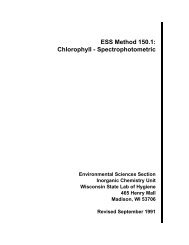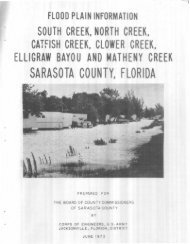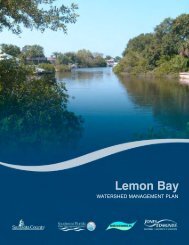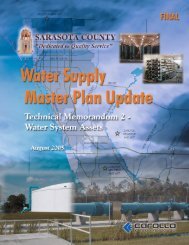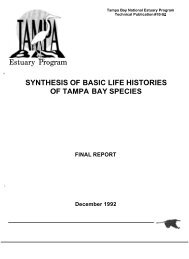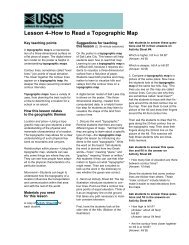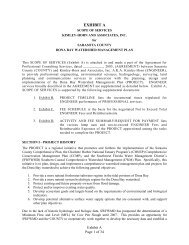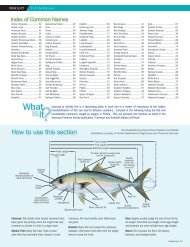Field Indicators of Hydric Soils in the United States - ITC
Field Indicators of Hydric Soils in the United States - ITC
Field Indicators of Hydric Soils in the United States - ITC
You also want an ePaper? Increase the reach of your titles
YUMPU automatically turns print PDFs into web optimized ePapers that Google loves.
<strong>Field</strong> <strong>Indicators</strong> <strong>of</strong> <strong>Hydric</strong> <strong>Soils</strong>*Gleyed matrix. <strong>Soils</strong> that have a gleyed matrixhave <strong>the</strong> follow<strong>in</strong>g comb<strong>in</strong>ations <strong>of</strong> hue, value,and chroma and <strong>the</strong> soils are not glauconitic:1. 10Y, 5GY, 10GY, 10G, 5BG, 10BG, 5B, 10B, or5PB with value 4 or more and chroma 1; or2. 5G with value 4 or more and chroma 1 or 2;or3. N with value 4 or more; or4. (for test<strong>in</strong>g only) 5Y, value 4 or more, andchroma 1.In some places <strong>the</strong> gleyed matrix may changecolor upon exposure to air (reduced matrix).This phenomenon is <strong>in</strong>cluded <strong>in</strong> <strong>the</strong> concept <strong>of</strong>gleyed matrix.*Hemic. See Mucky peat.Histic epipedon. A thick (20–60 cm [8–24 <strong>in</strong>])organic soil horizon that is saturated with waterat some period <strong>of</strong> <strong>the</strong> year unless artificiallydra<strong>in</strong>ed and that is at or near <strong>the</strong> surface <strong>of</strong> am<strong>in</strong>eral soil.Histels. Organic soils that overly permafrost andshow evidence <strong>of</strong> cryoturbation. See USDA,NRCS, Soil Taxonomy (1999) for completedef<strong>in</strong>ition.Histosols. Organic soils that have organic soilmaterial <strong>in</strong> more than half <strong>of</strong> <strong>the</strong> upper 80 cm(32 <strong>in</strong>), or that are <strong>of</strong> any thickness if overly<strong>in</strong>grock or fragmental materials have <strong>in</strong>tersticesfilled with organic soil materials. See USDA,NRCS, Soil Taxonomy (1999) for completedef<strong>in</strong>ition.Horizon. A layer, approximately parallel to <strong>the</strong>surface <strong>of</strong> <strong>the</strong> soil, dist<strong>in</strong>guishable from adjacentlayers by a dist<strong>in</strong>ctive set <strong>of</strong> propertiesproduced by soil form<strong>in</strong>g processes. See USDA,NRCS, Soil Taxonomy (1999) for completedef<strong>in</strong>ition.<strong>Hydric</strong> soil criteria.1. All Histels except Folistels and all Histosolsexcept Folists, or2. <strong>Soils</strong> <strong>in</strong> Aquic suborders, great groups, orsubgroups, Albolls suborder, Aquisalids,Histor<strong>the</strong>ls, and Histoturbels great groups,and Cumulic or Pachic subgroups that are:a. somewhat poorly dra<strong>in</strong>ed with a watertable equal to 0.0 foot from <strong>the</strong> surfacedur<strong>in</strong>g <strong>the</strong> grow<strong>in</strong>g season, orb. poorly dra<strong>in</strong>ed or very poorly dra<strong>in</strong>ed andhave ei<strong>the</strong>r:(1) water table equal to 0.0 foot dur<strong>in</strong>g<strong>the</strong> grow<strong>in</strong>g season if textures arecoarse sand, sand, or f<strong>in</strong>e sand <strong>in</strong> alllayers with<strong>in</strong> 20 <strong>in</strong>ches, or for o<strong>the</strong>rsoils; or(2) water table at less than or equal to 0.5foot from <strong>the</strong> surface dur<strong>in</strong>g <strong>the</strong>grow<strong>in</strong>g season if permeability isequal to or greater than 6 <strong>in</strong>ches perhour <strong>in</strong> all layers with<strong>in</strong> 20 <strong>in</strong>ches; or(3) water table at less than or equal to 1foot from <strong>the</strong> surface dur<strong>in</strong>g <strong>the</strong>grow<strong>in</strong>g season, if permeability is lessthan 6 <strong>in</strong>ches per hour <strong>in</strong> any layerwith<strong>in</strong> 20 <strong>in</strong>ches; or3. <strong>Soils</strong> that are frequently ponded for long orvery long duration dur<strong>in</strong>g <strong>the</strong> grow<strong>in</strong>g seasonor4. <strong>Soils</strong> that are frequently flooded for long orvery long duration dur<strong>in</strong>g <strong>the</strong> grow<strong>in</strong>g season.<strong>Hydric</strong> soil def<strong>in</strong>ition (1994). A soil that formedunder conditions <strong>of</strong> saturation, flood<strong>in</strong>g, orpond<strong>in</strong>g long enough dur<strong>in</strong>g <strong>the</strong> grow<strong>in</strong>g seasonto develop anaerobic conditions <strong>in</strong> <strong>the</strong> upperpart.Hydrogen sulfide odor. The odor <strong>of</strong> H2S, which issimilar to rotten eggs.Hydromorphic. Features <strong>in</strong> <strong>the</strong> soil caused orformed by water.Layer(s). A horizon, subhorizon, or comb<strong>in</strong>ation <strong>of</strong>contiguous horizons or subhorizons that shareproperty(s) referred to <strong>in</strong> <strong>the</strong> <strong>Indicators</strong>.Lithologic discont<strong>in</strong>uity. Occurs <strong>in</strong> a soil that hasdeveloped <strong>in</strong> more than one type <strong>of</strong> parentmaterial. Commonly determ<strong>in</strong>ed by a significantchange <strong>in</strong> particle-size distribution, m<strong>in</strong>eralogy,and o<strong>the</strong>r properties that <strong>in</strong>dicate adifference <strong>in</strong> material from which <strong>the</strong> horizonsformed.Land Resource Region (LRR). These geographicareas are characterized by a particular pattern<strong>of</strong> soils, climates, water resources, and landuse. Each LRR has a different letter <strong>of</strong> <strong>the</strong>alphabet (A–Z). LRRs are def<strong>in</strong>ed <strong>in</strong> USDAAgriculture Handbook 296.Many. When referr<strong>in</strong>g to redox concentrations and/or depletions, many represents more than 20percent <strong>of</strong> <strong>the</strong> observed surface.Marl. An earthy, unconsolidated deposit consist<strong>in</strong>gchiefly <strong>of</strong> calcium carbonate mixed with clay <strong>in</strong>approximately equal proportions, formed primarilyunder freshwater lacustr<strong>in</strong>e conditions.Complete def<strong>in</strong>ition <strong>in</strong> description USDA NRCS,Soil Taxonomy (1999).Matrix. The dom<strong>in</strong>ant soil volume that is cont<strong>in</strong>uous<strong>in</strong> appearance and envelopes microsites. Whenthree colors exist, such as when a matrix,depletions, and concentrations are present, <strong>the</strong>matrix may represent less than 50 percent <strong>of</strong><strong>the</strong> total soil volume.(430, FIHS, Ver. 5.01, March 2003) 27



